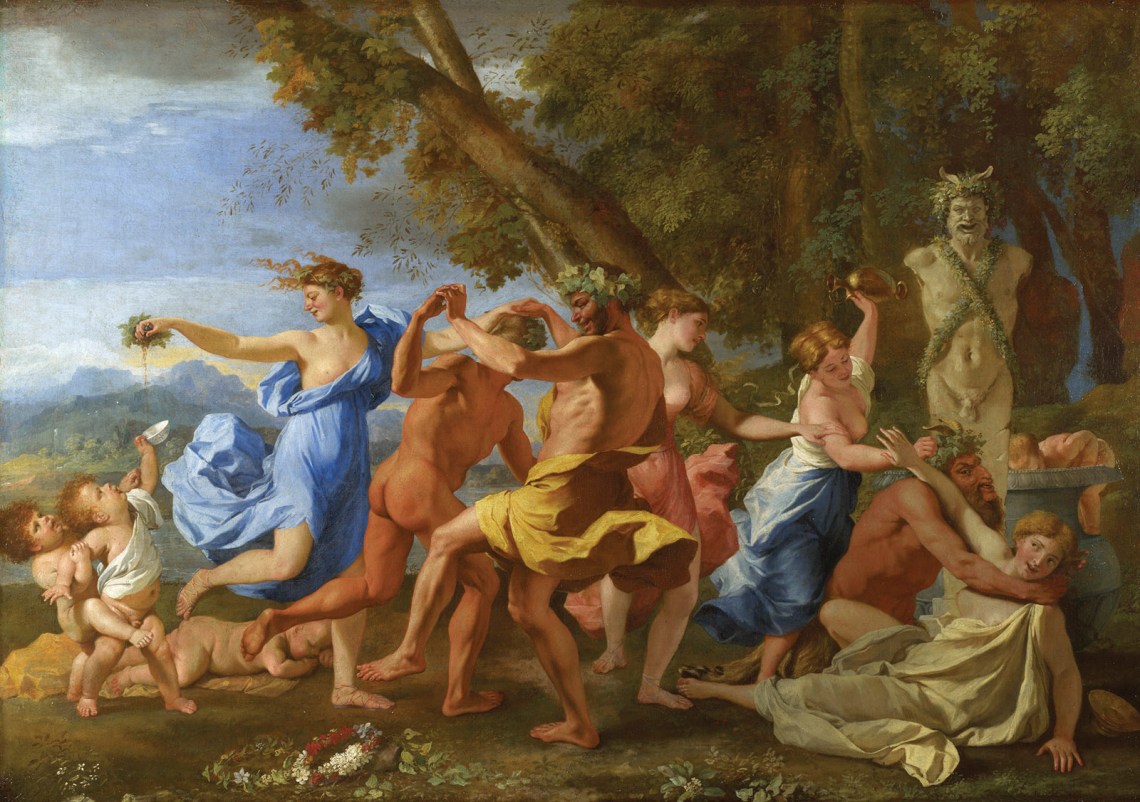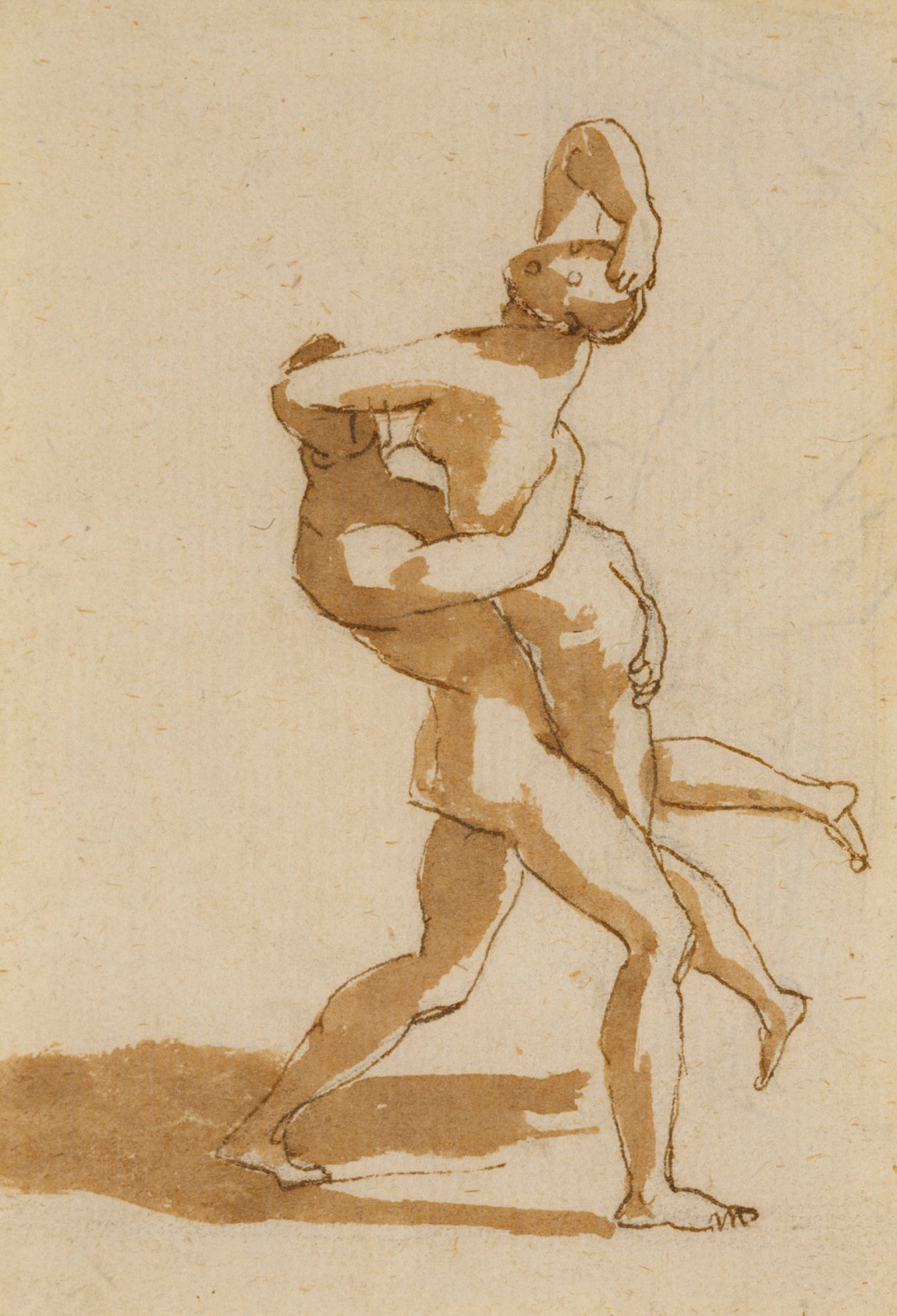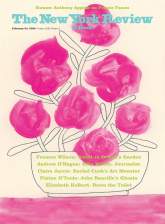Silken flounces flying up, his golden, hers blue, up he kicks, out she twists, his right hand takes her left and the naked man slips through: onward, to pursue the girl in rose who wants to hold back her wilder friend—the one who, helping that drunk girl the goat-man is reaching to grab, hoists up a wine vase she would smash down on his head. Above the goat horns, the old stone god by whose grove they’ve all gathered stands rigid, blindly grinning. Out beyond the leaves hover faraway mountains, and before them a tag-along party of toddlers appears—one already slumped sozzled, and two soon to follow, felled by the grape juice the girl in blue is squeezing. Whether Bacchus or Priapus—wine or fertility—is the name to which that statue answers, no one seems sure.
But as I roll my eyes around Nicolas Poussin’s Bacchanalian Revel Before a Herm, relishing its intricate interplay of limbs and drapes and summer air, the rest of me slides their way: I likewise long to dance and perhaps to get drunk. This large, breathy canvas—more than four and a half feet wide—is a highlight of an exhibition that adopts a single coordinate to track what the French painter was up to in Rome during his thirties and early forties, the years in which his career took off. The curators of “Poussin and the Dance,” Emily Beeny and Francesca Whitlum-Cooper, have brought together a few large canvases by the artist, a greater number of his drawings, and some items of antique sculpture, to illuminating effect.
Viewers reluctant to engage with the great eminence of French classicism may be surprised, and so may those who thought they knew him. The accents of the show are liable to alter when it travels from London’s National Gallery to the Getty Center in Los Angeles, where it will open with an adjusted selection of loans. But its catalog—which is a pleasure to read—demonstrates the rewards of an approach that focuses not simply on the artist but on the content of the art.
Dance speaks for itself. Many of us live to dance, or at least to witness a world in which there is dancing. Intuited not only by the dancers themselves but also by the wallflowers, there is the sense that the comings and goings of bodies—the overall weave of events, that is, always and everywhere—have been distilled, wound tight, and above all quickened: made searingly alive, experienced in muscular action. In classical antiquity, those working in the more permanent arts of writing and sculpture were much struck by these thoughts, and concerned with how to reconcile this supreme and potentially delirious mode of human expression with more stable social forms. One speaker in a dialogue written in the first century ce by Lucian of Samosata traces “dancing back to the creation of the universe; it is coeval with that Eros who was the beginning of all things.” He is defending the art against an interlocutor disinclined to watch ballet performers who “mimic the passions of prehistoric strumpets…. These are not amusements for a gentleman.”
In the exhibition we meet a relief made at much the same date, which later became known as the Borghese Dancers. Its artist had devised a graceful way to harmonize the priorities of the gentleman with those of Eros: a line of five women in flowing chitons who swirl this way and that, their hand-linked chain punctuating the orderly gaps between the columns of a portico. Prior to that sculptor, others in the Hellenistic era had infused fleeting time—the dancer’s preserve—into their own solid medium, picking out chasing, cavorting figures on the faces of mighty marble vases that viewers were invited to circumambulate, in this way participating in a kinetic endlessness. These pieces—the Borghese Vase, the Salpion Vase—were must-sees for any pilgrim such as Poussin who had journeyed to Italy to pay homage to its art, and accordingly they find a place in the show.
We are invited to think about the education that the painter then underwent. Reaching Rome in 1624, when he was nearly thirty, Poussin came equipped with classical schooling (his family were minor provincial gentry) and experience in turning out history paintings (pieces that are now lost), although his pockets were empty and his lone contact, the poet Giambattista Marino, not long afterward left town. Through Marino, however, he was pointed toward Cassiano dal Pozzo, the secretary to the pope’s nephew, who soon commissioned the earliest canvas here. This Bacchus and Ariadne, on loan from the Prado, is a burly fantasia, energetically reshuffling the revelers and satyrs Titian had conjured up when addressing the same theme a century before. Its five-and-a-half-foot-wide expanse of jumbled, flailing limbs reads as the audition of a newcomer happy to treat canvases as processional friezes and to cleave to a well-established taste for imagery based on Ovid.*
Advertisement
But Cassiano had further work for Poussin, in effect a reschooling. He hired the needy but studious Frenchman to provide descriptive drawings for his “Paper Museum,” a project meant (as far as we can now follow its purposes) to act as a visual master key to all fields of information. The ancient past was a priority among these, partly because its lost systems of knowledge presented prototypes for the enterprise now at hand, partly because its histories and myths resembled an anthropologist’s field for research. There is a quasi-scientific equanimity in the way the figures of the Bacchanalian Revel—painted some years after Poussin entered Cassiano’s ambit, around 1632—have their meanings upturned in The Adoration of the Golden Calf, painted for Cassiano’s cousin Amedeo. Those carefree dancers now reappear, under storm clouds and the crags of Sinai, as a false god’s idolaters. Whatever the inflection—blithe pagan rite, grave biblical wrong—dance constituted a primal human activity, and such habits of the species formed the remit of the painter-investigator that Poussin was now becoming.
Above all, his methods moved on. If those reappearing dancers are seen from a different angle, this is because they possessed an additional, three-dimensional existence as redeployable wax figurines. Making such models, Poussin was adopting procedures already extant among Rome’s more academic painters, helped along by his friend the sculptor François Duquesnoy. The pair of them, heeding Cassiano’s passions for “antiquity and rationality” (as one historian has defined them), liked to clamber over Rome’s ancient marbles, applying measuring tapes so as to rediscover their rhythmic principles, which they would bring back to the studio to infuse into little sculptures of their own.
The exhibition features, on a rotating dais, a waxwork of two bodies locked in struggle that has been reconstructed from one of the sparest of Poussin’s drawings, a record of the pattern of shadows that lamplight would have cast upon the piece. From foundations such as this, multiplicities of linked figures, often briskly summarized in blocks of ink wash, would expand to enliven the frieze-like pictorial spaces that Poussin preferred. He was not the first to tackle history painting using a box occupied by dolls and their candle shadows, but he lent the strategy a tougher logic. “Toy theater” has been one epithet for it; “observation tank” might be more fitting. If human interactivity was the research topic, one needed to stand outside.
Poussin explored insistently the transitions from three dimensions to two, and a delight of the show is the thoroughness of his curiosity. At one end, his attentions to an antique bas-relief or malleable mannequin; at another, his exquisitely evolved surface patterns on canvas, or else on paper, in the presentation drawings that are also on view. Much of the beauty comes from Poussin’s marvelous inventiveness with swooshing, airborne draperies that colorfully counterpoint the interlocking limbs of the dancers. Having started life as larvae of wax and pupated as tonal blocks, these dancers take on fleshliness—by way of life studies, no doubt—but rarely emerge as distinct individuals. Their faces remain generic.
This was in line with the way that Poussin, as he developed his ideas, reconceived the status of the paintings he was producing: he would bring it nearer to that of the musical forms on which the dances relied. From pictures consisting of persons in spaces, he would switch to devising spaces with overall emotional dispositions or “modes”—the gaiety that lifts me up when I look at that Revel, the lurid tension instilled by the Golden Calf’s tonalities. Both these and other compositions were variations on a set of structural constants: that humans flourish when they unite in curviform frenzies, and that in opposition to this—as, indeed, the Borghese Dancers relief proclaims—there remains their quest for stability, for the orthogonality of porticos, herms, and altars.
Surveying this body of work from the 1630s, the decade in which Poussin achieved renown, you can imagine how a Roman and French clientele—several of whom, as Beeny mentions, were involved with contemporary ballet—warmed to a new aesthetic that combined an abstracting nonchalance with a ready joie de vivre. The painter’s own dancing days may well have been over—he was now a married man who, according to a friend, would peel away from “companions in amusement,” “even on feast days,” preferring to draw—but in the studio his instinct for jollity stayed vigorous. The presentation sheets abound in fumbles, tumbles, erections, and ornery goats. Besides, all this misrule was set at a mythical and pastoral remove from the precisely calculated choreography of seventeenth-century balls. Perhaps polite society had always dandled dreams of a golden age and its sensual abandon with a faintly bad faith. In Poussin’s canvases even as in antique reliefs, the gamesome strumpets remain strictly prehistoric.
Advertisement
If Poussin owed something to Cassiano in the formation of this new taste, another intellectual, Giulio Rospigliosi, rerouted it when, around 1634, he commissioned A Dance to the Music of Time based on an iconography of his own devising. This concise and finely poised allegory (which crossed London from the Wallace Collection to the National Gallery but will not proceed to the Getty) spells out an economic cycle—Poverty pursuing Labor, Labor leading to Wealth, Wealth to Pleasure, in whose wake returns Poverty—via a four-person wheel, slow-stepping to the rhythm that old Father Time is plucking on his lyre. It reads as the vision of a moralist not encountered in other paintings. I am led to suspect that with Poussin, much in the art depends on who he is talking with. The suspicion is underlined because although this superbly curated show addresses a commanding pictorial intelligence, there are points at which it leaves me baffled.
In the six-foot-wide Realm of Flora, the dancer is a goddess saluted in a poem of Ovid’s. We meet her skipping around her pergolaed garden, strewing beneficent petals on a gathering of familiars from other Ovidian fables—Narcissus pining for his own reflection, Hyacinth mortally wounded by Apollo’s discus, and so on. Each, as their names suggest, undergoes suffering and death to metamorphose into a flower, and thus from their bodies we see blossoms sprout up. Technically this canvas of 1630–1631 was a startling makeover of Poussin’s hitherto tenebrous act, introducing delicate, softly golden harmonies; moreover, figure by figure, the relations of its poses and surface patterns are fascinating. Yet the picture’s emotional logic feels nonsensical. It carries no weight: What analogue in experience could there be for this “realm” in which a suicide may proceed to a dainty redemption? What I read is a painter trying, on his own account, to piece together an arch conceit after the manner of Marino, the patron who had brought him to Rome—but remaining as yet (like this mentor, perhaps) a poet more pretentious than profound.
The canvas was worked up for a high-society crook named Fabrizio Valguarnera, out of whose hands a Roman court soon seized it when he was brought to trial in 1631. Poussin’s client in the case of three paintings of Triumphs—orgiastic celebrations of Pan, Bacchus, and Silenus—was more formidable, if further removed: the mighty Cardinal Richelieu. By the mid-1630s the chief minister of Louis XIII was demanding dance-based pieces from the fashionable new French name on the Roman art scene to show off at the château he was building in Touraine. (Visitors to the Getty will get to see a further grand commission, the four-yard-wide Hymenaeus Disguised as a Woman During an Offering to Priapus, which was dispatched from Rome to the king of Spain.)
The order clearly put Poussin on his mettle. Uniquely, multiple preparatory drawings for the Pan and the Bacchus have survived, demonstrating the urgency and mobility of his hunt for design solutions. Exhibited here, they allow you almost to hear Poussin’s breathing. But then you turn to the brushwork that was delivered to Richelieu and you are rebuffed: primped, burnished, and glitzy, its aggressive artificiality serves as a kind of armor. It is reassuring to turn to the catalog and read that famed Poussin authority Anthony Blunt remarking that the Triumph of Pan was “painted without love.” A paraphrase might be that it was painted in fear of power, by an artist whose instinct was rather for intellectual friendship.
The third piece for Richelieu’s château, the Triumph of Silenus with its uncomfortable vertical format, looks as if it was abandoned with a shrug—sometime, perhaps, in the painter’s early forties. So ended, very likely, the singular late education of a driven mind wrestling with driven bodies and rediscovering ancient tactics for holding them in view. Dance had pointed Poussin to music and thus to his new notion of paintings as vehicles for emotional modes—a doctrine not everyone cares for to this day, yet to argue with him beats agreeing with a hundred more affable artists. Meanwhile, in 1637 Poussin began devising for Cassiano his first series of Sacraments—the anthropologies of Christian religion that would intermittently occupy him for the next eleven years—and from that date until the painter’s death in 1665, there would be no more reels and revelries. The players had been paid off.
This Issue
February 24, 2022
Liberation Psychology
‘Invitations to Dig Deeper’
Riffraff
-
*
Coincidentally, visitors to the Metropolitan Museum in New York have just been given an opportunity to view a very different piece from this phase of Poussin’s career: a portrait-format Agony in the Garden painted on copper, newly donated to the museum by Jon and Barbara Landau. ↩





